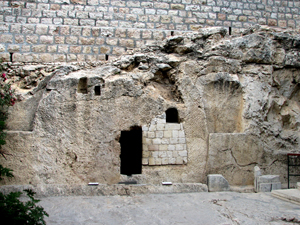
The Garden Tomb is a reused 9-7th Cent BC tomb in a part of the vast cemetary north of present-day Old City of Jerusalem, believed by some, esp. Protestant, Christians to be the burial site of Jesus.
☰ See Where

The reused tomb in the the Garden Tomb.
Protestant visitors to Jerusalem find it difficult to fathom how the gaudy spirituality of the Holy Sepulchre could have been the site of Jesus' crucifixion and burial. The Garden Tomb is also known as Gordon's Tomb, after General Charles Gordon (the English general who made his name helping to put down the Taiping Revolution in China and, later, by his horrifying death at the hands of the Mahdi uprising in Sudan in 1884). He visited the site in 1883 and though he recognized the shape of a skull in a limestone hill there (archaeologists now believe the hill was given its present form much later than the 1st Cent). Nearby he also found a tomb in the setting of a garden. He quickly concluded, and pursuaded many others (including the Anglican Church) to believe that he had found the real tomb of Jesus. "Sanity eventually prevailed, and the Anglican Church withdrew its formal support, but in Jerusalem the prudence of reason has little chance against the certitude of piety" (Jerome Murphy-O'Connor).

The 'eye sockets' piercing out of the hill that Charles Gordon saw as Golgotha. It is situated back of the main bus station.
The Garden Tomb, which is today lovingly maintained by the always polite and helpful volunteers of the Garden Tomb Association, seems so much more condusive for such a place. The shape and structure of the garden tomb, however, is such that it is extremely difficult to harmonize with the Gospel account of the disciples' encounter with Jesus at the tomb. Archaeologically, therefore, it is almost certain that this could not have been the tomb used to bury Jesus for the three days of his death. Artifactual evidences suggest that the site was used for stabling horses by the Crusaders. Furthermore, there are obvious signs of vandalism on the tomb, which would have been unlikely had it been revered as the place of the Master's burial in the early days of the church.

Further Reading:
G. Barkay, "The Garden Tomb—Was Jesus Buried Here?" Biblical Archaeology Review 12/2 (1986):40-53, 56-57.
J. E. Taylor, "Golgotha" A Reconsideration of the Evidence for the Sites of Jesus' Crucifixion and Burial," New Testament Studies 44 (1998):180-203.

©ALBERITH
100415lch